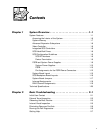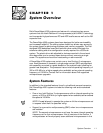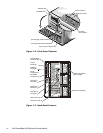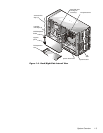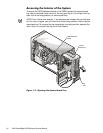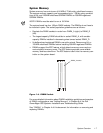
System Overview 1-1
&+$37(5
6\VWHP2YHUYLHZ
Dell
®
PowerEdge
®
4300 systems are feature-rich, enterprise-class server
systems that use Intel
®
Pentium
®
II microprocessor(s) with MMX
™
technology
and incorporate high-performance PCI and AGP local buses as well as the ISA
expansion bus.
The PowerEdge 4300 systems have been designed for better serviceability
and increased reliability. The sliding system board tray allows easy access to
the system board for performing processor and memory upgrades. The Dell-
designed SCSI backplane board and hard-disk drive carriers eliminate the
extensive cabling and drive configuration usually required for a SCSI sub-
system. The plastic drive rails attached to devices mounted in the external
drive bays allow you to remove these devices without removing a single
screw. The systems can be either freestanding or rack-mounted.
A PowerEdge 4300 system can contain one or two Pentium II microproces-
sors. Each processor is housed in a single-edge contact (SEC) cartridge/heat
sink assembly mounted in a guide bracket on the system board, allowing for
greater heat dissipation. The processor has an internal operating frequency of
350 or 400 MHz (or a higher speed when available) and an external operating
frequency of 100 MHz. Contact Dell for information about Dell-supported
microprocessor upgrades.
6\VWHP)HDWXUHV
In addition to the standard features found in a traditional personal computer,
Dell PowerEdge 4300 systems include the following new and/or advanced
features:
One or two Intel Pentium II microprocessors with an internal operating fre-
quency of 350 or 400 MHz (or higher speed when available) and an external
bus speed of 100 MHz.
NOTE: Do
not
attempt to operate the system with the microprocessor set
to a speed other than the specified rating.
Support for symmetric multiprocessing (SMP) when two microprocessors
are installed.
NOTE: The second microprocessor must have the same internal operating
frequency as the first microprocessor. Not all versions of the Pentium II
microprocessor will work properly as an additional microprocessor in this





